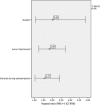Incidence of and associated factors for bacterial colonization of intravenous catheters removed from dogs in response to clinical complications
- PMID: 29602241
- PMCID: PMC5980313
- DOI: 10.1111/jvim.15118
Incidence of and associated factors for bacterial colonization of intravenous catheters removed from dogs in response to clinical complications
Abstract
Background: Infection rate associated with intravenous (IV) catheter placement is emerging as an important issue in small animal veterinary medicine, mostly because of the economic costs associated with these infections. Identification of possible associated factors may provide useful information for the surveillance and prevention of such infections.
Objectives: To determine the incidence of positive bacterial cultures obtained from IV catheters used in dogs hospitalized for at least 48 hours and removed because of clinical complication. To identify the bacteria involved and factors associated with bacterial colonization.
Animals: One-hundred eighty-two dogs that underwent IV catheterization from January 2015 to July 2015 at the Veterinary Teaching Hospital of Alfonso X el Sabio University of Madrid were enrolled in the study.
Results: The bacterial colonization rate of all IV catheters removed in response to clinical complications was 39.6%, the cumulative proportion of catheters that remained in place at 24, 48, and 72 hours after placement was 89.5, 78, and 59.4%, respectively. Multivariable Cox proportional hazards regression indicated significant associations for staff who performed catheterization (junior, P = .002; student, P = .034) and use of steroidal anti-inflammatory drugs (P = .036). The most frequently isolated bacterium was Acinetobacter spp. (21.7%).
Conclusions and clinical importance: The bacterial colonization incidence related to IV catheter placement was slightly higher than the incidence described in other veterinary studies. Associated factors not previously described in veterinary medicine were found. The most frequently isolated organism was Acinetobacter spp., indicating its importance as an emerging pathogen in catheter colonization.
Keywords: catheterization; microorganism; nosocomial; pathogen.
Copyright © 2018 The Authors. Journal of Veterinary Internal Medicine published by Wiley Periodicals, Inc. on behalf of the American College of Veterinary Internal Medicine.
Figures
Similar articles
-
Bacterial and fungal colonisation of peripheral intravenous catheters in dogs and cats.J Small Anim Pract. 2011 Oct;52(10):531-5. doi: 10.1111/j.1748-5827.2011.01101.x. Epub 2011 Aug 8. J Small Anim Pract. 2011. PMID: 21824149
-
Microorganism colonization of peripheral venous catheters in a small animal clinical setting.J Vet Emerg Crit Care (San Antonio). 2023 Sep-Oct;33(5):509-519. doi: 10.1111/vec.13328. Epub 2023 Aug 16. J Vet Emerg Crit Care (San Antonio). 2023. PMID: 37585353
-
Length of hospitalization, APPLE score, and number of intravenous catheters placed at admission are associated with increased odds of peripheral intravenous catheter complications in dogs.J Am Vet Med Assoc. 2023 Nov 1;262(1):1-7. doi: 10.2460/javma.23.05.0293. Print 2024 Jan 1. J Am Vet Med Assoc. 2023. PMID: 37918104
-
Prospective evaluation of complications associated with jugular venous catheter use in a veterinary hospital.J Small Anim Pract. 2010 May;51(5):254-7. doi: 10.1111/j.1748-5827.2010.00914.x. Epub 2010 Apr 6. J Small Anim Pract. 2010. PMID: 20402840
-
Types of urethral catheters for management of short-term voiding problems in hospitalized adults: a short version Cochrane review.Neurourol Urodyn. 2008;27(8):738-46. doi: 10.1002/nau.20645. Neurourol Urodyn. 2008. PMID: 18951451 Review.
Cited by
-
Prevalence of and risk factors for intravenous catheter infection in hospitalized cattle, goats, and sheep.J Vet Intern Med. 2020 Jan;34(1):330-338. doi: 10.1111/jvim.15684. Epub 2019 Dec 20. J Vet Intern Med. 2020. PMID: 31859417 Free PMC article.
-
Does Catheter Insertion Site Matter? Contamination of Peripheral Intravenous Catheters during Dental Scaling in Dogs.Vet Sci. 2024 Sep 3;11(9):407. doi: 10.3390/vetsci11090407. Vet Sci. 2024. PMID: 39330786 Free PMC article.
-
Inflammatory, Mechanical and Infectious Complications Associated with Peripheral Intravenous Catheters in Dogs and Cats: A Risk Factor Analysis.Vet Sci. 2022 Mar 6;9(3):118. doi: 10.3390/vetsci9030118. Vet Sci. 2022. PMID: 35324846 Free PMC article.
-
Placement, management and complications associated with peripheral intravenous catheter use in UK small animal practice.J Small Anim Pract. 2025 Jan;66(1):3-13. doi: 10.1111/jsap.13782. Epub 2024 Sep 5. J Small Anim Pract. 2025. PMID: 39238283 Free PMC article.
References
-
- Eggimann P, Pittet D. Overview of catheter‐related infections with special emphasis on prevention based on educational programs. Clin Microbiol Infect. 2002;8:295–309. - PubMed
-
- Horan TC, Andrus M, Dudeck MA. CDC/NHSN surveillance definition of health care‐associated infection and criteria for specific types of infections in the acute care setting. Am J Infect Control. 2008;36:309–332. - PubMed
-
- Blot F, Nitenberg G, Chachatty E, et al. Diagnosis of catheter‐related bacteraemia: A prospective comparison of the time to positivity of hub‐blood versus peripheral‐blood cultures. Lancet. 1999;354:1071–1077. - PubMed
-
- Maki DG, Mermel LA. Infections due to Infusion Therapy In: Bennett JV, Brachman PS, eds. Hospital Infections. Philadelphia: Lippincott‐Raven; 1998:689–724.
MeSH terms
LinkOut - more resources
Full Text Sources
Other Literature Sources
Miscellaneous



